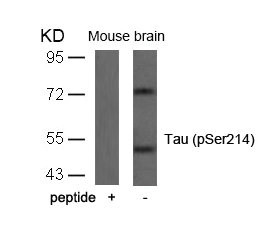
Western blot analysis of extracts from mouse brain tissue using Tau(Phospho-Ser214) Antibody and the same antibody preincubated with blocking peptide.
Phospho-MAPT (Ser214) Antibody
CSB-PA135965
ApplicationsWestern Blot, ELISA
Product group Antibodies
ReactivityHuman, Mouse, Rat
TargetMAPT
Overview
- SupplierCusabio
- Product NamePhospho-MAPT (Ser214) Antibody
- Delivery Days Customer20
- ApplicationsWestern Blot, ELISA
- CertificationResearch Use Only
- ClonalityPolyclonal
- ConjugateUnconjugated
- Gene ID4137
- Target nameMAPT
- Target descriptionmicrotubule associated protein tau
- Target synonymsDDPAC; FTDP-17; G protein beta1/gamma2 subunit-interacting factor 1; MAPTL; microtubule-associated protein tau; MSTD; MTBT1; MTBT2; neurofibrillary tangle protein; paired helical filament-tau; PHF-tau; PPND; PPP1R103; protein phosphatase 1, regulatory subunit 103; TAU; tau-40
- HostRabbit
- IsotypeIgG
- Protein IDP10636
- Protein NameMicrotubule-associated protein tau
- Scientific DescriptionPromotes microtubule assembly and stability, and might be involved in the establishment and maintenance of neuronal polarity. The C-terminus binds axonal microtubules while the N-terminus binds neural plasma membrane components, suggesting that tau functions as a linker protein between both. Axonal polarity is predetermined by tau localization (in the neuronal cell) in the domain of the cell body defined by the centrosome. The short isoforms allow plasticity of the cytoskeleton whereas the longer isoforms may preferentially play a role in its stabilization. Smet C, et al. (2005) FEBS Lett; 579(19): 4159-64. Puig B, et al. (2005) Acta Neuropathol (Berl). Gvtz J, et al. (2001) Science; 293(5534): 1491-5. Illenberger S, et al. (1998) Mol Biol Cell; 9(6): 1495-512.
- ReactivityHuman, Mouse, Rat
- Storage Instruction-20°C or -80°C
- UNSPSC12352203
